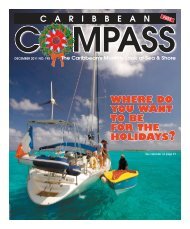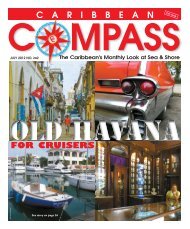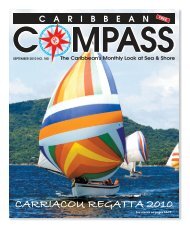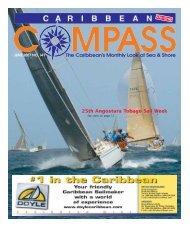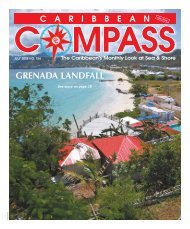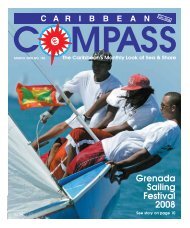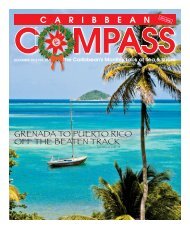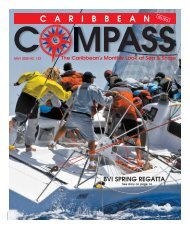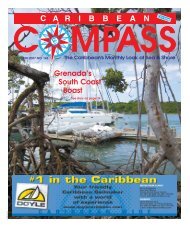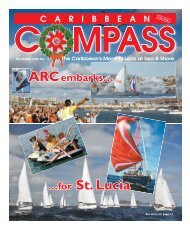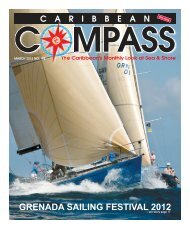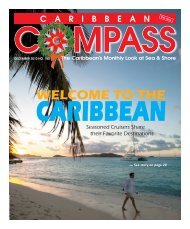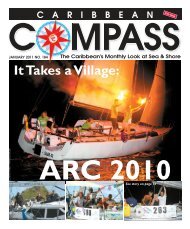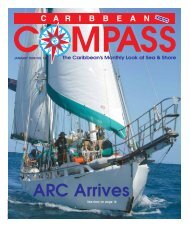Carriacou Regatta Festival 2007 - Caribbean Compass
Carriacou Regatta Festival 2007 - Caribbean Compass
Carriacou Regatta Festival 2007 - Caribbean Compass
You also want an ePaper? Increase the reach of your titles
YUMPU automatically turns print PDFs into web optimized ePapers that Google loves.
—Continued from previous page<br />
As we entered the town we felt like we had gone back<br />
in time. The buildings had been perfectly restored and<br />
preserved. This was pleasing to the eye and confusing<br />
Above: At Golden Rock Estate we were greeted by Pam<br />
Huggins Barry, a descendant of the original owner<br />
to the mind, as the only evidence of this modern age<br />
was the flow of automobiles. What a great entry to a<br />
new island for us and a pleasant surprise. No pushy<br />
cabbies and no hucksters flogging wares greeted us.<br />
People just went about their business, but taking the<br />
time to give us a glance and a greeting.<br />
Our first day was a day of discovery which meant visiting<br />
the tourist office, conveniently located on Main<br />
Street next to the post office and near the dinghy landing.<br />
We explored the downtown area and found the<br />
sidewalks narrow or non-existent. We just copied the<br />
locals as they negotiated the traffic on the streets. At<br />
one point there was a pick-up truck stopped on the<br />
street and from the back the driver was selling a load of<br />
bright yellow honeydew melons. Locals were gathered<br />
around and he was passing out samples. We also had a<br />
sample and purchased the juicy, sweet fruit. Also, to<br />
our delight, we paid the same price as the locals.<br />
Back at our boat it didn’t take long to start investigating<br />
what else Nevis offered, as our first day was<br />
completely delightful. The information obtained from<br />
the tourist board office revealed an island that has<br />
taken great care to preserve the evidence of their past<br />
and maintain the natural beauty of their island.<br />
(Guess what, no garbage strewn around.) Among the<br />
main island attractions are the preserved sugar mills<br />
whose towers can be easily seen from a distance.<br />
On Day 2 we caught a local bus from Charlestown to<br />
a side road leading to Golden Rock Estate, a sugar<br />
plantation dating back to 1801. A fine quality resort<br />
has replaced the crude sugar refining equipment, and<br />
a 50-foot, mountain-spring-fed swimming pool was<br />
originally built as a cistern. This resort has been managed<br />
since 1975 by Pam Huggins Barry, a direct<br />
descendent of the original owner. The management<br />
encourages artists and eco-minded tourists to enjoy<br />
their resort. For hiking, there are marked nature trails<br />
which wind their way through the plantation grounds<br />
and up Mount Nevis to the top. Another choice is a<br />
shorter 30-minute route through the plantation, which<br />
has been consumed by the rainforest. If exploring on<br />
these trails from mid-afternoon onward you are highly<br />
likely to spot wild African Green (Vervet) monkeys. The<br />
monkeys occupying the forested plantation grounds<br />
are nourished by mango trees which are in abundance.<br />
We arrived at the plantation around noon and were<br />
greeted by Pam Huggins Barry who provided us with<br />
maps and intriguing stories about the plantation’s past.<br />
Before heading out to hike, we had lunch, enjoying a<br />
delicious carrot soup and a cold beer in the outdoor<br />
restaurant. The menu suggested high quality<br />
cuisine choices with moderate prices. The<br />
peace and quiet allowed us to focus on the beautiful<br />
gardens and lush tropical surroundings.<br />
With great anticipation we set out, with a<br />
hand-drawn map provided by Pam, along a<br />
rainforest trail marked Upper Round Road<br />
with hope of seeing the monkeys. The trail<br />
marker is a black circle and has a triangle<br />
with a U in the center. This road runs midway<br />
up Mount Nevis and was the interconnecting<br />
road around the mountain for the sugar plantations<br />
built in the late 1600s. This trail follows<br />
the contour of the mountain and though<br />
designed to carry heavy carts, with a bedding<br />
of smooth round stones carpeted in short<br />
grasses, it makes for excellent walking, biking<br />
and horseback riding. It can take up to five<br />
hours to cover the nine-mile trek of the complete<br />
road; however, our trek was but a short<br />
section of it giving us a sample of the pure<br />
magic of this ancient road through the rainforest.<br />
Here we spotted at close range a Green<br />
Monkey who stopped momentarily on the road<br />
and looked at us in as much surprise as we<br />
looked at it. Then in a single leap it went over the<br />
embankment and disappeared into the forest.<br />
We exited the forest, taking a short-cut back<br />
to town on a residential road. Reaching the<br />
main road, we hailed a bus and rode back to<br />
the main dinghy dock.<br />
Day 3 began with another visit to the tourist<br />
board office to ask whether the Botanical<br />
Gardens were open. The tourist office phoned<br />
them and confirmed they were. Learning we<br />
were cruisers, the staff in the tourist board<br />
office became enthusiastic and informed us<br />
that the islanders are very serious about developing<br />
the island as a cruising stop. They then<br />
introduced us to the Nevis Air and Sea Ports<br />
Authority General Manager, Spencer Hanley.<br />
Mr. Hanley informed us that beginning in<br />
August <strong>2007</strong> they would commence the progressive<br />
installation of 100 moorings for yachts<br />
up to 60 feet. The moorings will run along the<br />
west coast of the island from Oualie Beach to<br />
Charlestown (including Pinney’s Beach). In addition<br />
there will be a designated area for mega-yacht moorings.<br />
They will also be improving their dinghy dock<br />
and providing cruisers’ services such as showers,<br />
internet access, laundry services and water. Full boatmaintenance<br />
services are being planned for the<br />
future.<br />
We then visited a rustic mineral-spring bath facility<br />
which is a 15-minute walk from the dinghy dock.<br />
Located above the spring are the<br />
remains of a hotel dating back to 1778.<br />
The mineral-rich spring, with a faint<br />
sulphur odor, is believed to contain<br />
healing qualities. A large concrete bath<br />
and a natural spring-fed creek which<br />
runs alongside the Bath House are<br />
both available for public use at no<br />
charge. We tested the waters and they<br />
were comfortably warm.<br />
To reach the Botanical Gardens you<br />
can take a bus to the road access, followed<br />
by a one-mile walk. We arrived<br />
to find ourselves the only visitors. As<br />
it was July, at the end of the dry season,<br />
the flora and fauna was burned<br />
by the sun and only the hardiest flowers<br />
were in bloom. There was still<br />
interest and wonderment at every<br />
turn. During the moist months, this<br />
property (according to photos) transforms<br />
into a tropical wonderland of<br />
lush colors and textures. The<br />
Botanical Gardens are known for<br />
their unique variety of orchids.<br />
A one-half mile trek up the road led<br />
us to the Montpelier Estate. On the<br />
left side of the road is a very large,<br />
old, silk cotton tree where the British<br />
naval hero Lord Nelson married Fanny Nisbet, a beautiful<br />
Nevisian widow, in 1787. (Imagine a tree living<br />
that long.) A short jaunt up the road was the sugar<br />
mill for the plantation which has been converted into<br />
a luxurious resort. We were free to roam the grounds<br />
and house properties. We found them all very interesting,<br />
inviting and well-preserved including many<br />
photos and paintings dating back to the 18th century.<br />
We hiked back to the main road where we caught a<br />
bus to Charlestown for EC$2.50 each. (Taxis are also<br />
available for all locations.)<br />
On Day 4 we took one of the hourly ferries which run<br />
between Charlestown and Basseterre, the capital of St.<br />
Kitts. The one-way fare per person was US$8 for the<br />
ferry and EC$1 for the port tax. The crossing took about<br />
one hour on the Sea Hustler, though the faster Carib<br />
Surf cat ferry takes only 35 minutes for the same price.<br />
(We came back on Carib Surf.) We explored Basseterre’s<br />
downtown area, which included a dressed-up cruise<br />
ship dock facility and town square called Circus, fashioned<br />
after London’s Piccadilly Circus.<br />
Changing gears from the romantic Nevis to the metropolitan<br />
area of St. Kitts, we found ourselves hurrying<br />
along to the bus depot by the harbour. From there we<br />
caught a bus marked “Sandy Point” heading north<br />
along the coast road to Brimstone Hill Fortress. The ride<br />
was a shock as the bus drivers maneuver their vehicles<br />
as though they were in a Grand Prix race, completely<br />
ignoring road speed limits and any measure of safety.<br />
We found ourselves tense, white-knuckled and totally<br />
uncomfortable although the locals appeared relaxed.<br />
This gave us some confidence that the buses actually<br />
reach their destination.<br />
The climb to the fort is a mile and a quarter up a<br />
paved, steep and narrow winding road. Taking our<br />
time, we reached the fort in about 40 minutes. On<br />
the way up we stopped at a fascinating lime kiln<br />
which was apparently built in the 1700s to manufacture<br />
lime for the mortar used in building the fortress.<br />
This kiln is a large stone cauldron with fire pits<br />
around the base and steps leading to the top for loading.<br />
It was amazing to see the quality of the construction<br />
and to imagine labourers carting containers<br />
of limestone or coral to dump into the cauldron.<br />
These are things we have never seen before in our<br />
travels as in most locations time has destroyed the<br />
evidence of the engineering tools of the past. This<br />
gave us even more excitement about what we would<br />
find at the top of the hill.<br />
The name Brimstone is well suited as the fortress is<br />
built on an 800-foot volcanic dome which still emits a<br />
slight sulfurous odor. The fort tour cost US$8 each<br />
plus an optional single cost of US$5 for an audio guide<br />
of the site which we highly recommend. Though recognized<br />
by the world as one of the best preserved 18th<br />
century military architectural accomplishments, we<br />
found the fort more interesting from the point of view<br />
that it was a military assignment designed to protect<br />
Britain’s sugar interest on the island which was<br />
threatened by France. Around the fort in all directions<br />
lie the remains of sugar plantations including current<br />
sugarcane fields. The site is in excellent condition considering<br />
its age.<br />
Arriving back in the city we were quick to get to the<br />
ferry dock and catch the first ferry back to the tranquility<br />
of Nevis. The contrast between the two islands<br />
is dramatic and we found ourselves longing for the<br />
beautiful anchorage where our floating home was<br />
waiting. On the way, as we passed our anchorage<br />
about a half mile offshore, we spotted a bright yellow<br />
dinghy adrift. It appeared to be our neighbouring<br />
yacht’s dinghy (as no other yacht in the area that we<br />
were aware of had a yellow dinghy). We decided we<br />
would recover the dinghy for our neighbour, so as<br />
soon as we got off the ferry we hopped into our dinghy<br />
and headed straight for it. Our neighbours later<br />
Taking a ferry to St. Kitts one day, we toured the<br />
18th century Brimstone fortress<br />
explained they had left the dinghy on the beach and<br />
the tide and wind had drifted it away. They were<br />
pleased to recover it.<br />
Our four days spent in this anchorage provided<br />
some of the most peaceful, interesting and eco-centered<br />
adventures we’ve come across since leaving the<br />
Bahamas. We cannot help but think that cruisers who<br />
sail right on by Nevis are missing one of the cruising<br />
life’s best-kept secrets. It truly is a walk on the wild<br />
side where man has kept the wild preserved and safe.<br />
Bill and Bev Bate are cruising the <strong>Caribbean</strong> aboard<br />
S/V El Shaddai.<br />
SEPTEMBER <strong>2007</strong> CARIBBEAN COMPASS PAGE 25



